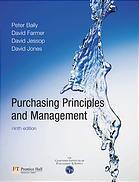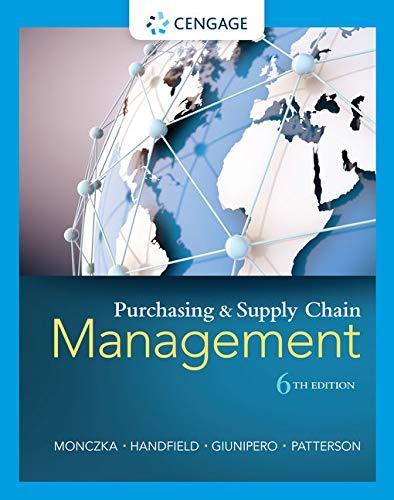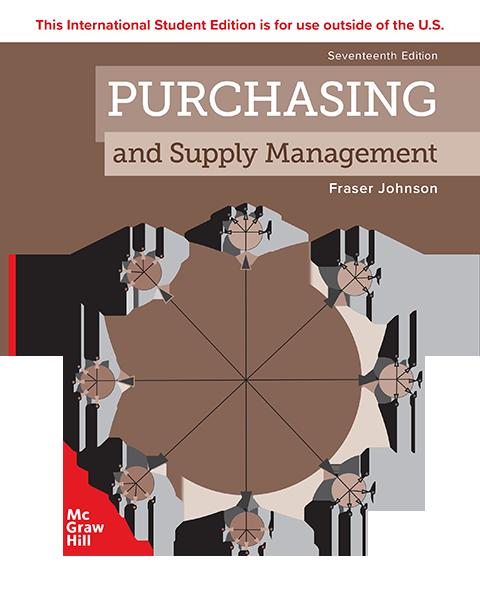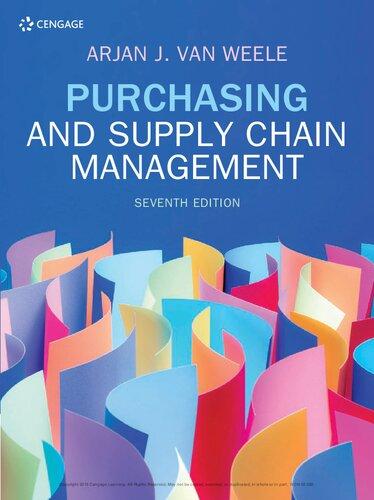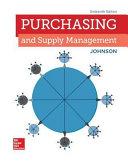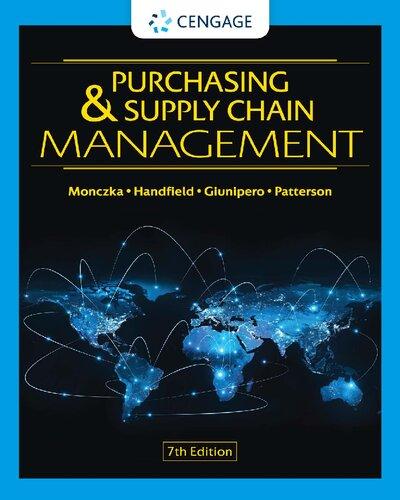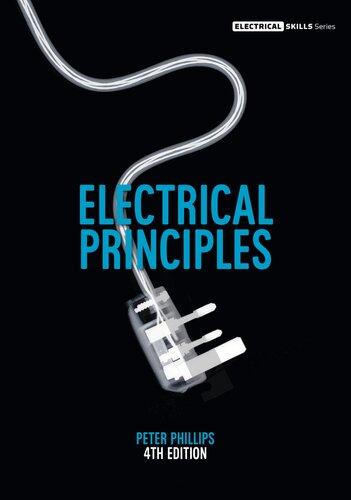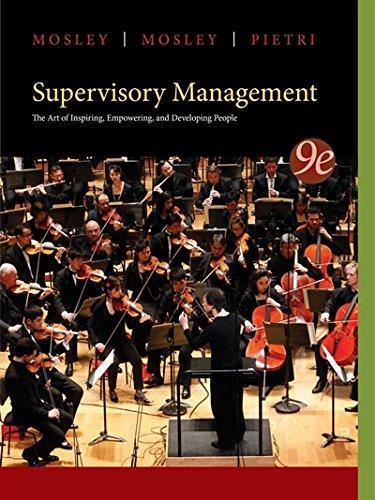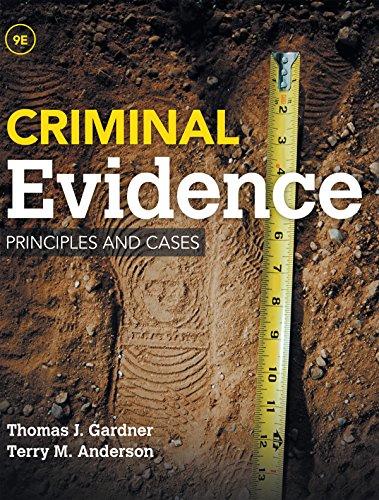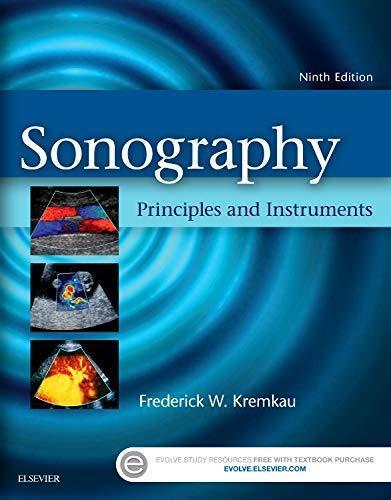Purchasing Principles and Management
Ninth Edition
PeterBailyBSc(Econ),ACIS,FCIPS
DavidFarmerMSc,PhD,FCIPS,Dip.Man.Studies,Dip.Mktg.
DavidJessopBA,FCIPS,FILog,ICSA,Cert.Ed.
DavidJonesPhD,MSc,BSc(Econ),MCInstM,MBIM,Cert.Ed.
Pearson Education Limited
EdinburghGate
Harlow
EssexCM202JE
England
andAssociatedCompaniesthroughouttheworld
Visit us on the World Wide Web at: www.pearsoned.co.uk
Firstpublished1968
Ninth edition published 2005
©InstituteofPurchasingandSupply,1968,1974
©PeterBailyandDavidFarmer,1977,1981,1985,1990
©PeterBaily,DavidFarmer,DavidJessop,DavidJones,1994,1998,2005
Allrightsreserved.Nopartofthispublicationmaybereproduced,stored inaretrievalsystem,ortransmittedinanyformorbyanymeans,electronic, mechanical,photocopying,recordingorotherwise,withouteithertheprior writtenpermissionofthepublisheroralicencepermittingrestrictedcopying intheUnitedKingdomissuedbytheCopyrightLicensingAgencyLtd, 90TottenhamCourtRoad,LondonW1T4LP.
ISBN0273646893
British Library Cataloguing-in-Publication Data
AcataloguerecordforthisbookisavailablefromtheBritishLibrary 10987654321 0908070605
Typesetin9.5/13ptstoneby35
PrintedandboundinGreatBritainbyAshfordColourPress,Hampshire
The publisher’s policy is to use paper manufactured from sustainable forests.
Softerapproachtoplanning64
Valueanalysis/valueengineering132 Summary134 Referencesandfurtherreading135
6Therightquantity136 Introduction136
Objectivesofthischapter136 Provisioningsystems136 Orderquantitiesandstockcontrol137
Orderquantitiesforproduction145
Distributionresourceplanning(DRP)150 Enterpriseresourceplanning(ERP)151 Just-in-time(JIT)151
7Time160
8Sourcedecision-making177 Introduction177 Objectivesofthischapter177
Thenatureofthesourcingdecision177 Attributesofagoodsupplier179 Differenttypesofsourcing179 Sourcingdecisions180 Thesourcingprocess183 Sourcelocation183
Sourcesofinformationonpotentialsuppliers184 Supplierevaluation185
Therightrelationship190 Otheraspectsofsourcing192 Partnering200
1 Purchasing scope and development
Introduction
Allorganisationsneedinputsofgoodsandservicesfromexternalsuppliersor providers.Inthischapterweexaminethedevelopingroleofthepurchasingand supplyfunctioninmanagingtheseinputs,andcommentuponthewaysinwhich theactivitycancontributetotheefficiencyoftheorganisation.Wewillidentify waysofmeasuringthestageofdevelopmentreachedbyanorganisationand demonstratehowthedevelopmentstagereachedcanaffectperformanceofthe purchasingactivity.
Objectivesofthischapter
n Todiscussthescopeofpurchasing
n Toidentifythepurchasingcycleconcept
n Todiscusspurchasingandsupplyasaserviceactivity
n Todiscussthechangingroleofpurchasingandsupply
n Toexplainhowpurchasingmightdevelopfromanindependentfunctiontoan integratedactivity
n Toidentifytheinternalandexternalinfluenceswhichhaveaffectedtheevolution ofpurchasing
n Toexaminethe‘totalacquisitioncost’concept
n Toconsidertheadoptionofrelationshipsbasedonmutualbenefitsasanalternativetothetraditionaltransactional,adversarialapproach
n Tohighlighttheevolutionofconceptsrelatingtopurchasingdevelopment
n Toidentifykeypracticesencounteredindevelopedstrategicpurchasing.
Thescopeofpurchasing
A well-known statement of the objectives of purchasing is: to acquire the right quality of material, at the right time, in the right quantity, from the right source, at the right price. This somewhat hackneyed statement is criticised by
some as being rather superficial and simplistic. This is undoubtedly valid comment, though the definition does provide a practical starting point for discussion, and has been useful to the authors in organising this textbook. However, a good objective should be measurable in some way, but who is to say, for example, what price is right? For present purposes, remembering the need to work as an effective function in the management team, the following broad statement of objectives is suggested:
n To supply the organisation with a flow of materials and services to meet its needs.
n To ensure continuity of supply by maintaining effective relationships with existing sources and by developing other sources of supply either as alternatives or to meet emerging or planned needs.
n To buy efficiently and wisely, obtaining by an ethical means the best value for every pound spent.
n To maintain sound co-operative relationships with other departments, providing information and advice as necessary to ensure the effective operation of the organisation as a whole.
n To develop staff, policies, procedures and organisation to ensure the achievement of these objectives.
In addition, we might add some more specific objectives such as:
n To select the best suppliers in the market.
n To help generate the effective development of new products.
n To protect the company’s cost structure.
n To maintain the correct quality/value balance.
n To monitor supply market trends.
n To negotiate effectively in order to work with suppliers who will seek mutual benefit through economically superior performance.
n To adopt environmentally responsible supply management.
n Thepurchasingcycle
The main stages in the purchasing process may be summarised as follows:
n Recognition of need
n Specification
n Make or buy decision
n Source identification
n Source selection
n Contracting
n Contract management
n Receipt, possibly inspection
n Payment
n Fulfilment of need
The idea of the purchasing cycle is often employed to indicate the main activities in which purchasing might be involved. The activities included in the cycle do not include all of those that a purchasing staff might be involved with; there are many activities such as, for example, negotiation, vendor rating and source development that are not specifically included. It will be noticed that the early and late stages in the cycle may not necessarily involve specialist purchasing staff, the core purchasing contribution to the cycle being the items included in the central part of the list.
A limitation of the cycle concept is that it does not recognise the strategic contribution made by modern purchasing. We shall discuss this contribution within this chapter and elsewhere in the text.
n Ispurchasingaserviceactivity?
The thinking prevalent at the time of the first edition of this book was that purchasing was a service function, often subordinated to production or engineering in the manufacturing sector, or to finance in the service or public sectors. The idea was that specialist supplies staff could do the bidding of the more strategic elements of the organisation, and employ their skills at a secondary ‘support’ level. Thinking moved on, and there came a more general realisation that purchasing might contribute more effectively at a strategic as well as an operational level. The idea that purchasing and supply was merely a support activity has been somewhat discredited, with a developing recognition that purchasing involvement in issues such as the ‘make or buy’ decision, or strategic commercial relationship gave the function a central and strategic role in the competitive organisation.
Paradoxically, the now widespread recognition of the strategic nature of much of the work of the purchasing staff has led to a kind of reversion. It is now widely thought, and practice reflects this thinking, that high level purchasing expertise is best employed in determining supply strategy in line with that of the corporation, and assisting those concerned with day-to-day operations in reflecting this strategy in managing their own acquisition and use of externally sourced products and services. In many concerns purchasing is again seen as a service or support activity, but by no means a servile function. In much the same way top management is often depicted these days as supporting the organisation, inverting the traditional view that the organisation supports its management. We discuss the development of purchasing later in the book, but we offer at this stage the idea that in many cases purchasing has moved through evolution of its role to devolution of much of the more straightforward buying activity, whilst retaining and developing its strategic contribution.
Thechangingroleofpurchasingandsupply
As we have indicated, purchasing is seen by many of today’s successful organisations as an activity of considerable strategic importance. However, not all businesses see purchasing as a function best undertaken by a specialised department. There are those who perceive the activity as being more appropriately performed close to the point of need of the goods or services being acquired. It is probably true to say, though, that a majority of organisations employ the services of a dedicated team of purchasing and supply specialists. This book is concerned with that specialised role.
The fact that the strategic role and contribution of purchasing and supply is well recognised in many leading commercial concerns has meant that the strategic purchasing decisions may be taken by purchasing involvement at board level, rather than by a departmental manager.
The role and contribution of purchasing has increased steadily over the past 50 years, with a dramatic upsurge in interest in the activity taking place relatively recently. There are a number of reasons for this shift in importance and recognition, and the main ones can be summarised as follows:
n Externalorganisationalfactors
Leading-edge concepts
Fewerbutlarger suppliers
Organisations employing leading-edge approaches to the management of materials are putting into practice integrative ideas, which are, at least in part, based on a strategic and integrated role for purchasing. The demonstrated success of these organisations is stimulating great interest, and as other organisations attempt to replicate their success, so purchasing is brought to the fore.
Approaches and concepts which might be considered under this heading are:
n best practice benchmarking
n total quality management
n just-in-time philosophies and lean production
n supply chain concepts
n tiering and empowerment of suppliers
n relationship management
n customer focus
The expression ‘world class concepts’ is sometimes employed to describe these and similar ideas, meaning something like ‘world’s best’ or ‘as used by the world’s leading organisations’. In order to achieve such concepts, however, purchasing needs to be well developed and proactive.
Concentration in the supply market has had a profound effect in recent years. For example, the number of iron foundries in the UK has been decimated; the production of pharmaceutical products is almost entirely in the hands of a
Increasing environmental awareness
small number of large organisations; only a handful of large European chemical companies remain; and there is now only one British car manufacturer of any significant size. This process of concentration through amalgamations, takeovers and the failure of the smaller and less viable business units continues. It poses obvious problems for purchasing and supply, and ensures a higher profile and more strategic role for the function.
The recognition has dawned, perhaps belatedly, that it is good business sense to be ‘green’, and to be seen to be responsible in this respect. Recycling, the specification of renewable raw materials, a greater concern with the effects of waste and by-products, wider concern for the use of returnable packaging, and many other related concerns, all have implications for purchasing and are affecting perceptions of the function. This area is examined in more detail in Chapter 4.
Competitoractivity
Customerdemands
When attempting to develop new ideas pressure is often placed on an organisation to look at what levels of performance competitors and other organisations are achieving. The term ‘benchmarking’ is often given to this process, but benchmarking is not simply copying good ideas. Demonstration of the real benefits that a developed supply function confers on the rest of an organisation has been a stimulant for other companies to improve that function, and this in turn has raised the profile of purchasing.
The customer is now seen by many as being all-important. Philip Kotler, the marketing guru, talks about delighting the customer, i.e. exceeding customer expectations. Satisfying is silent while delighting is noisy. It is no longer acceptable to give a second-best service if you want to remain profitable and retain market share. Organisations are more ‘customer driven’, and these driving forces impact upon purchasing.
Advancing technology
Finiteresources
Technology and associated complexity has meant that most businesses now specialise in a narrower range of activities and are compelled to buy a greater proportion of their requirements from those who have the specialist expertise, patents, intellectual property or design rights associated with complex or advanced technology.
Some natural resources have, of course, always been finite. However, increasing recognition that their use and consumption needs to be planned has had a profound effect on the role of purchasing in contributing to the planned and responsible use of these resources, whether driven by simple economic forces or a growing sense of social responsibility.
Government intervention
There are varying degrees of government and trading bloc involvement in the marketplace. This can take the form of price controls, or control of monopolies and restrictive practices, health and safety and so on. Of particular
TheChartered Instituteof Purchasingand Supply(CIPS)and thecontribution ofpurchasing
interest has been the privatisation of large parts of the former public sector. Audit reports have been particularly critical of procurement in the public sector, where purchasing has tended to be inefficient. With privatisation, purchasing functions quickly began to copy practices found in the private sector.
In more recent years organisations in the public sector, comprising public health authorities, local authorities, defence procurement and the former nationalised industries, have spent considerable time and effort in attempts to improve their purchasing and supply activities. In some cases they still have some way to go to catch up with advanced purchasing organisations in the private sector, though of course not all ‘best practice’ is found in the private sector, and not all private sector purchasing is advanced. Recent changes in local government have meant that now ‘budget holders’ are the major decision makers. They do not have to use centrally negotiated contracts, and in the pursuit of value for money they can source from whom they like. In the past the centrally negotiated contracts did not necessarily offer what clients considered to be value for money. The net effect of these changes in the public sector has been that the central purchasing agencies have become more commercially orientated and have begun to ‘market’ their services to users.
European Union directives, currently undergoing significant revision, have also put pressure on European purchasing to develop a more enlightened sourcing policy. Tenders over a given threshold (reviewed periodically) have to be advertised in the Official Journal of the European Community ( OJEC ), thereby allowing greater opportunities for suppliers within the EU.
In the early 1990s the Institute of Purchasing and Supply was granted a Royal Charter. This was a landmark in the development of the purchasing and supply function, and it is now more widely regarded as a truly professional activity. The Institute has spent considerable time and effort at a national level demonstrating the importance and contribution of effective purchasing in both the public and private sectors. Its examination scheme and courses have done much to enhance the status of the purchasing function, and the CIPS is now represented on many government committees where purchasing issues are discussed.
This heightened awareness of the purchasing and supply function is certainly a factor in improving the general development of the activity across the UK. As an example, the Department of Trade and Industry has published booklets on the benefits of a proactive purchasing function, and organised ‘road shows’ to increase awareness. It has also offered consultancy services to those smaller organisations that wish to improve their purchasing expertise. This growth and development has also taken place in the professional bodies representing purchasing and supply professionals in many other countries.
Changing patternsoftrade
With the growth of larger trading blocs such as the European Union, the opening up of Eastern Europe and improvements brought about by the World Trade Organisation (formerly known as GATT), markets have become inter-
Table1.1 Somereasons fortheincreased importanceand recognitionof purchasing Increasing proportionof revenuespent externally
Labour and overheads
TOTAL ORGANISATIONAL EXPENDITURE
Externally provided resources
Innovation
Decreasing because of:
l automation
l moreefficientwork
l competitivenessdepending onaccessto‘bestpractice’
Increasing because of:
l greaterspecialisationonpartofbuyingorganisations
l ‘outsourcing’policies
l focusoncorecompetencies
l developmentofspecialisedcontractors
l easieraccesstoworldsupplymarket
l complextechnologyrestrictingbreadthof‘make’ capabilities
l flexibilitydependingonexternalratherthan dedicated‘owned’assets
l closerco-ordinationwithkeysuppliers
national. The traditional administratively-orientated purchasing function had considerable difficulty in adapting to these changes. Most buyers would source for the most part within their domestic economy, whereas those more aware would be attempting to buy where the best value could be attained. As organisations think globally and integrate their purchasing activities across countries, they are often able to reduce costs of bought-out materials dramatically.
As outlined in Table 1.1, organisations are spending a greater proportion of their income externally and less on internal costs such as wages and overheads. With the increased share of the expenditure comes an increasing responsibility for purchasing.
Practice note
In order to obtain greater leverage from its purchasing expenditure, IBM has since the late 1990s sourced a major proportion of its high value items on a global basis, achieving considerable cost savings. In order to achieve this it was necessary to employ integrated computer systems, and common coding systems were developed across all IBM operating locations. Global buyers now negotiate contracts that are used by the total organisation.
The pace of change has quickened over the years. Organisations must be able to develop new practices and products quickly and effectively. This in turn requires significant improvements in the internal interface between purchasing on the one hand and production, marketing, finance and so on on the other, as well as with external suppliers and customers. As product life cycles get shorter, reaction times are being compressed. Purchasing must be prepared to help initiate new ideas and developments. A good deal of attention is
Technology
being paid today to ‘time to market’ initiatives. New products cannot be developed and marketed rapidly without a proactive purchasing function.
The pace of technological progress means that organisations must have plans in place to handle development and purchasing needs to be actively involved. An example may be found in the development of e-commerce. It is imperative that purchasing has an appropriate supplier base and is involved with suppliers who can jointly develop and use this approach to business.
While we have examined some of the important general factors and trends that affect the development of the purchasing activity, there is no doubt that there are other external variables at work that are more specific to particular organisations.
n Internalorganisationalfactors
Although there is considerable pressure from outside to develop the purchasing function, it is often internal influences that initiate the changes. These internal influences include the following factors.
Theleveland percentagesof purchasedgoods andservices
Figure1.1
Theincreasing importanceof purchasingand supplyinthe manufacturing sector
Normally, as the external expenditure increases as a proportion of the total, greater attention is paid to the input activities. For example, in large automotive, electronic and retail organisations, percentages of bought-out material and services expenditure in relation to sales income run at between 60 and 90 per cent. Clearly this expenditure is of crucial importance and needs close attention at policy level. It is interesting to note that this proportion has been increasing steadily for many years (see Figure 1.1).
Integratedsystems As a system becomes more integrated within an organisation and the provision of information increases, so the likelihood of discovering inefficiencies within that system also increases. Input activities are therefore crucial to the development of integrated systems; their stage of development must match what is required to make the integrated systems work effectively. The more advanced the computer systems, the greater the possibilities of reducing routine work carried out by input staff. Time can then be spent concentrating on more effective purchasing. Integrated systems organise and disclose enormous amounts of information about the workings of the total system. If senior management were not aware of the possibility of substantial savings and improvements in efficiency in the purchasing areas, they soon would be as integrated systems developed. Growth of e-commerce means that even Small and Medium Enterprises (SMEs) need to develop such systems.
Structuralchanges Moves towards materials management and logistics concepts have in turn helped to develop the purchasing and supply function. In almost all cases the amount of attention paid to purchasing and supply has risen.
Performance measurement
There has been more emphasis in recent years on measurement. Within organisations that measure the contribution of the purchasing and supply function, its status is usually affected in a positive way. Senior management become aware of its contribution to cost reduction and its strategic capabilities, and in consequence are far more likely to promote its development.
Proactivepurchasing
As the level of attention paid to purchasing and supply increases, the work tends to become more strategic in emphasis, concentrating more upon such activities as negotiating longer-term relationships, supplier development, and total cost reduction, rather than ordering and replenishing routines. If we examine the responsibilities of buyers in organisations with a welldeveloped function – such as IBM, Nissan, Ford, Baxi, Hewlett Packard and others – we find that they spend only a small proportion of their time on administrative and clerical activities. Most of their activity concentrates on the establishment and development of appropriate relationships with suppliers. The emphasis in such organisations has evolved beyond simply reacting to the needs of users as and when they arise, to a forward-looking proactive approach that more fully reflects the contribution that the management of inputs can make. Table 1.2 compares and contrasts reactive with proactive purchasing.
n Thechangingnatureofrelationships
A simplistic view of purchasing activity is that it is merely buying; that in essence it consists of finding a supplier who is willing to exchange the goods
Table1.2
Reactive buying
l Purchasingisacostcentre
l Purchasingreceivesspecifications
l Purchasingrejectsdefectivematerial
l Purchasingreportstofinanceor production
l Buyersrespondtomarketconditions
l Problemsaresupplier’sresponsibility
l Priceiskeyvariable
l Emphasisontoday
l Systemsindependentofsuppliers
l Usersordesignersspecify
l Negotiationswin/lose
l Plentyofsuppliers = security
l Plentyofstock = security
l Informationispower
Proactive buying
l Purchasingcanaddvalue
l Purchasing(andsuppliers)contributeto specification
l Purchasingavoidsdefectivesupplies
l Purchasingisamainmanagementfunction
l Purchasingcontributestomakingmarkets
l Problemsareasharedresponsibility
l Totalcostandvaluearekeyvariables
l Emphasisstrategic
l Systemsmaybeintegratedwithsuppliers’ systems
l Buyersandsupplierscontributetospecification
l Negotiationswin-win(orbetter)
l Plentyofsuppliers = lostopportunities
l Plentyofstock = waste
l Informationisvaluableifshared
or services required for an agreed sum of money. This perception of purchasing has become known as the ‘transactional’ view, and is based on the idea that purchasing is concerned with simple exchanges, with buyer and seller interacting with each other on an arm’s-length basis. The underlying interest of the buyer in this rather simple scenario is to acquire as much resource as possible for as little money as it is necessary to pay.
It is true to say that this transactional view is not obsolete; it is still an appropriate way of looking at the process whereby low-cost items, for which there are plenty of competing suppliers, might be purchased. However, it is no longer thought to be a suitable basis for most organisational purchasing expenditure.
Much more attention has been paid in recent years to the development of ‘mutual’ supplier–buyer relationships, where the benefits of doing business together arise from ideas of sharing as well as exchanging. In a mutual relationship the emphasis is on building a satisfactory outcome together, with, for example, such things as technology. Confidence and support are invested by both sides with the intention of adding value, a process not possible with a simple transaction. The organisations concerned seek to come closer together and to identify overlapping interests. These ideas will be referred to later in the text, but it is important at this stage to be aware of the developing nature of purchasing and supply work, and the complexity which accompanies this development.
Figures 1.2 and 1.3 enable a comparison between the transactional and the mutual relationship. The list of shared benefits is by way of example only and will vary between relationships.
Figure1.2
The‘transactional’ relationship
Figure1.3
The‘mutual’ relationship
Procurementpositioning
Of course, it is not the case that any organisation will wish to develop mutual or partnership relationships with all of its suppliers. Pareto’s principle applies: it will generally be found that 80 per cent of expenditure will be with 20 per cent of suppliers; and it is likely to be the suppliers with whom large sums of money are spent who will be the ones with whom closer relationships are sought. A useful tool in determining those suppliers with whom close relationships might best be sought is the ‘Procurement Positioning’ tool based on the work of Kraljic (1983) illustrated by Figure 1.4. The vertical axis, labelled ‘Risk’, is concerned with the degree of difficulty associated with sourcing a product or service, or the vulnerability of the client organisation to a failure of the supplier to provide the product or service on time, or to the failure ‘in service’ of a supply. The horizontal axis, ‘Profit potential’, is used to indicate the extent of the potential of the supply to contribute to the profitability (or efficiency) of the buying concern. This profit potential might be realised by achieving lower costs, either by paying a lower price for a good or service or by introducing more efficient buying methods.
Figure1.4
The‘Procurement
Positioning’tool
It will readily be seen that there is no single best approach to relationships: a transactional approach might well be seen as appropriate for the routine purchases, whereas a strategic approach will be of obvious benefit to a mutual relationship in the critical sector. A buyer is likely to be uncomfortable with suppliers of services or goods in the leverage sector, and may well wish to move the requirement to the routine sector – perhaps by developing additional suppliers – or to the critical sector, by attempting in some way to increase the seller’s dependence. Where supplies and suppliers are in the leverage category, buyers are likely to feel quite comfortable, though of course we must expect that vendors will be keen to see their products or services repositioned as critical.
Totalacquisitioncost(andtotalcostofownership)
Buying price is probably the factor most often associated with procurement responsibilities. The procurement function has an important role in judging the correct price for any purchase and this aspect of the task is seen at its most dramatic in the commodity markets. Since prices are affected by costs, at least in the long run, an important function of procurement is to work with colleagues and suppliers to eradicate unnecessary costs. These could result from over-specification; purchasing a non-standard item when an alternative standard is acceptable; unnecessary packaging and, where significant transport costs are involved, the design of the product in terms of transportation utility.
The total acquisition cost is more than simply price, and has a bearing on developing the wider role of purchasing into total cost management. It is the total you actually pay for goods and services, including such things as tooling, duty, inventory-carrying costs, inspection, remedy or rectification and so on.
Figure1.5 Theprice/cost iceberg
It is an obvious fact, yet a commonly ignored one, that a low price may lead to a high total acquisition cost. Of course, once materials or goods have been acquired, they may attract further costs while in use. With this in mind, some organisations prefer the expression ‘Total Cost of Ownership’ when referring to capital goods or materials that will be retained for some time.
Price is the most visible of the various costs, which arise from making most acquisitions, and in many cases it will be the biggest component of cost too. The ‘price/cost iceberg’ shown in Figure 1.5 helps us to remember the hidden costs, and to account for them in our business decision-making.
The importance of purchasing and supply as a key function in the management of a business can be emphasised by considering the total acquisition cost of materials and services, and this is of course influenced by the specification being purchased. In turn, this may involve marketing and a desire to have an attractive product to sell. It will involve production and the need to minimise disruptions in production and can involve resulting scrap or waste and even transportation costs. As many value analysis studies have shown, the cost-saving potential in this area is considerable and the procurement function has a vital part to play in the search for the optimum specification. One problem in corporate management is that there tend to be dominant functions in particular companies; in one it will be marketing, in another finance or production. This results in that function being given attention at the expense of the overall operation. We shall return to the theme of price and cost later in the book.
n Specification
The procurement function has a part in working towards the optimum specification. This implies not only an attractive product for marketing to sell
